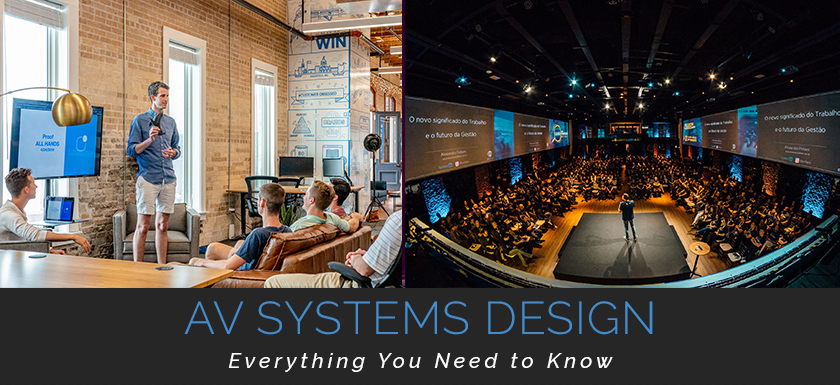
What is AV systems design?
AV systems design refers to the process of planning, specifying, and implementing audio and video technology systems for various applications such as live events, conference rooms, and educational institutions. It involves the selection and integration of components such as microphones, speakers, projectors, and control systems to deliver high-quality audio and video experiences.
What does an AV systems designer do?
An AV systems designer is responsible for designing and integrating audio and video systems for various applications. This includes tasks such as:
- Understanding client requirements and conducting site surveys
- Selecting and specifying audio and video equipment
- Designing system architecture and creating technical drawings
- Programming control systems and configuring network systems
- Testing and commissioning the system
- Providing technical support and training to end-users.
The goal of an AV systems designer is to create functional and user-friendly audio and video systems that meets the needs of the client and delivers high-quality audio and video experiences.
Here is a comprehensive list of products typically needed for AV systems design:
- Microphones (e.g. condenser, dynamic, lapel)
- Audio Mixers
- Amplifiers
- Speakers
- Projectors
- Screens
- Video Switchers
- Control Systems (e.g. Kramer, Atlona)
- Cables and Connectors
- Video Conferencing Systems
- Digital Signal Processors (DSPs)
- Streaming Encoders/Decoders
- Video Walls
- LED displays
- Media Servers
- Power conditioners/uninterruptible power supplies (UPS)
- Sound Reinforcement Systems
- Professional AV lighting systems
- Interactive Displays
- Loudspeaker Management Systems
- …and more
Importance of AV Control Systems in AV Systems Design

AV control systems play a crucial role in AV systems design as they allow for the centralized management of audio and video equipment.
An AV control system typically consists of a control processor, touch panel, and software that work together to provide a unified interface for managing various AV components.
Some benefits of using AV control systems in AV systems design include:
1. Ease of Use
AV control systems provide a user-friendly interface for controlling audio and video equipment, making it easier for users to operate the system.
2. Centralized Management
AV control systems allow for centralized management of multiple devices and systems, providing a single interface for controlling everything from volume levels to lighting.
3. Improved Flexibility
AV control systems can be programmed to adjust system settings based on user preferences and requirements, making it easy to change settings on the fly.
4. Greater Reliability
AV control systems can be programmed to automatically perform routine maintenance tasks, such as turning equipment off when not in use, reducing the risk of equipment failure.
5. Integration
AV control systems can be integrated with other systems such as lighting control, building management systems, and room scheduling systems, providing a unified control solution for the entire space.
AV control systems are a key component of AV systems design, helping to create user-friendly and reliable audio and video systems that can be easily managed and maintained.
AV Systems Design for Commercial Spaces

AV systems design for commercial spaces involves the planning, specification, and integration of audio and video technology to support the needs of businesses and organizations. The focus is on creating functional and user-friendly systems that enhance communication, collaboration, and presentations.
Key components of AV systems design for commercial spaces may include:
- Audio systems: Microphones, speakers, audio mixers, and amplifiers
- Video systems: Projectors, displays, video conferencing systems, and control systems
- Network systems: Ethernet switches, routers, and structured cabling
- Control systems: Touch panels, control processors, and software
- Digital Signage: Displays and media players
- Video walls: Arrays of displays used to create large video displays
- Lighting control: Dimmers, switches, and control systems
- Professional installation and integration services
The goal of AV systems design for commercial spaces is to create a seamless and integrated solution that meets the specific needs and requirements of each client, while delivering high-quality audio and video experiences.
Both Kramer and Atlona are reliable and well-established brands in the AV market and are both leading manufacturers of AV solutions, including a range of products for AV systems design. They offer AV control systems that provide a unified solution for managing audio and video equipment in commercial spaces.
The choice between them may depend on the specific needs and requirements of each project. It is recommended to compare the products and services offered by both companies, and to consult with a professional AV systems designer to determine the best solution for a specific project.
The following are some reasons to consider AV control systems from Kramer/Atlona:
1. User-friendly
Control systems are designed to be user-friendly, providing a simple and intuitive interface for controlling audio and video equipment, but the specific user interface and features may differ between the two companies.
2. Integration
Control systems can be integrated with their other Kramer/Atlona products, as well as third-party equipment, to provide a seamless and integrated solution.
3. Scalability
Control systems can be scaled to meet the needs of any commercial space, from small conference rooms to large auditoriums.
4. Reliability
Control systems are designed to be reliable and durable, ensuring smooth and seamless operation for years to come.
5. Support
Kramer/Atlona both provide comprehensive technical support and services, including training, design assistance, and programming services, to help ensure a successful installation, but the specifics of these services may vary between the two companies.
Top 10 Tips for Beginner AV Systems Designers
Here are some tips for beginners in AV systems design:
- Gain Knowledge: Stay current on industry trends and technologies, and continuously expand your knowledge of audio and video systems design.
- Build Relationships: Network with industry professionals and build relationships with suppliers, manufacturers, and contractors.
- Develop Technical Skills: Focus on developing your technical skills and expertise, including programming, networking, and system integration.
- Read, Study and Practice: Read industry-related books, attend workshops, and get hands-on experience through internships or real-world projects.
- Communicate Effectively: Develop strong communication skills to effectively communicate with clients and team members.
- Attention to detail: Pay close attention to detail, as mistakes in design or installation can have significant consequences.
- Stay organized: Stay organized and keep accurate records of equipment specifications, system diagrams, and test results.
- Focus on Quality: Maintain a focus on quality and strive to deliver high-quality audio and video experiences.
- Seek Mentorship: Seek out experienced mentors who can provide guidance and support as you grow in your career.
- Choose Quality Products: It’s essential to build your AV Systems from the ground up by choosing high-quality products that are reliable and cost-effective and can help deliver a seamless and high-quality audio and video experience.
Pacrad has everything you need for installing and managing audio and video equipment in commercial spaces.
